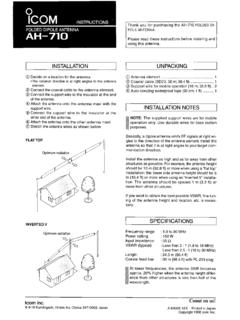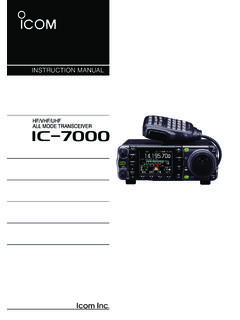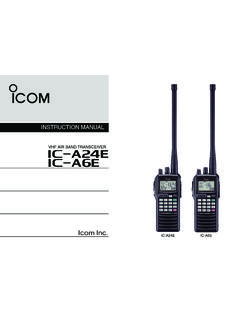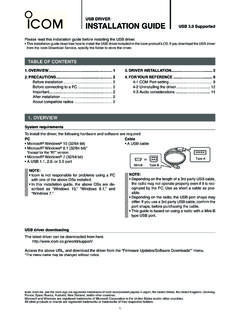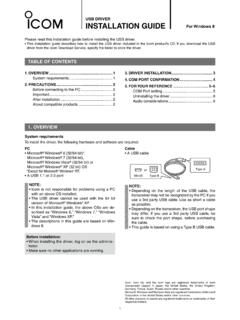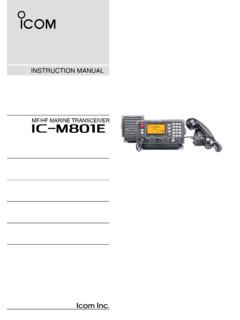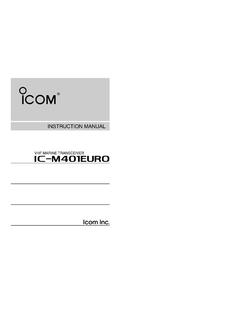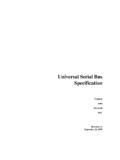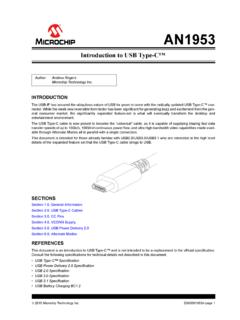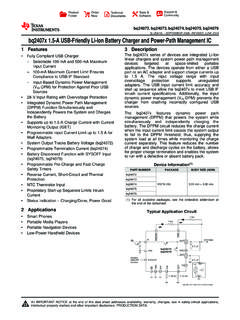Transcription of Tips for the USB port settings - Icom
1 Version March 2016. Reference MANUAL. Tips for the usb port settings TIPS for the usb port settings . PREFACE. Until recently, it has been necessary to change your PC data output to fit your transceiver's specifications when you operate RTTY. This is because the transceiver does not directly accept signals output from the PC's COM port. Therefore, you needed to use an interface unit between the transceiver and your PC. The interface unit adjusted the signals levels or signal format. Now, certain Icom transceivers have built-in RTTY mode. You can simply operate the modes with only your Icom transceiver itself. However, some users operate those modes with their PC connected through a USB. cable to synchronize with other software applications.
2 To connect between your Icom transceiver and PC through a USB cable, you do not need to think of signal level or signal format, and you do not need an interface unit to connect both units. Therefore, the connection becomes very simple. The USB port is used not only for RTTY and logging software operation, but also to remotely control the transceiver from a PC using the CI-V commands, to enter content into memory and to make settings using optional Icom cloning software. This document describes certain USB port settings . The applicable transceivers described in this document are as follows. (As of March 2016). IC-7100. IC-7300. IC-7850/IC-7851 (Referred to as the IC-7851). IC-9100. Note that a USB driver installation is required to connect the above transceivers to your PC.
3 The USB driver for Microsoft Windows PC can be downloaded from our website at: Refer to your transceiver's instruction manual for details on downloading the USB driver, and refer to the USB driver installation guide about installing the driver. This document describes only the concept of PC or network settings . Refer to your PC or software manual, or contact to their respective support center about the PC, software, or network settings . Please note that Icom cannot provide support for your PC, software, network or their proper settings Guide Revisions Icom reserves the right to make changes to the content of this guide at any time without notice or obligation. Trademarks/Copyright Icom, Icom Inc. and the Icom logo are registered trademarks of Icom Incorporated (Japan) in Japan, the United States, the United Kingdom, Germany, France, Spain, Russia, Australia, New Zealand, and/or other countries.
4 Microsoft and Windows are either registered trademarks or trademarks of Microsoft Corporation in the United States and/or other countries. All other trademarks are the properties of their respective holders. 2016 Icom Inc. 2. TIPS for the usb port settings . TABLE OF CONTENTS. SECTION 1 ABOUT DTR AND RTS .. 4. SECTION 2 ABOUT LINK SETTING FOR BETWEEN USB PORT AND REMOTE JACK .. 6. SECTION 3 WHY TWO VIRTUAL COM ports ARE RECOGNIZED ON ONE PHYSICAL. USB PORT .. 7. 3-1 How to check the internal circuit for each COM port .. 8. 3-2 How to change the COM port number .. 10. 3. TIPS for the usb port settings . SECTION 1 ABOUT DTR AND RTS . Applicable products: IC-7300, IC-7851 (as of March 2016). When connecting the above Icom amateur base transceivers to a PC using a USB cable, and operating an RTTY or logging software application, set either the DTR or RTS items in the transceiver Set mode settings of USB SEND, USB Keying (CW), and USB Keying (RTTY).
5 This section describes how to set these items. Figure 1-1 Set mode screen for IC-7300 Figure 1-2 Set mode screen for IC-7851. DTR stands for Data Terminal Ready, and RTS stands for TXD. Request To Send. They originated from the RS-232C standard, DTR RXD. which is a unified standard for the control signal line. GND 5 4 3 2 1 DCD. RI 9 8 7 6 DSR. The SEND and CW/RTTY keying signals from the PC through the DTR and RTS terminals of the RS-232C port or the sound card CTS RTS. are applied to the ACC socket on the transceiver. On some (Front view). transceivers with an RS-232C port, these signals are directly applied from the DTR and RTS terminals on the PC's RS-232C Figure 1-3 RS-232C connector pin port through an RS-232C cable.
6 Assignment (DB9). TX. Software RX. operation Mark Space RTS (Used for the transceiver's Output signals transmit and receive switching.). to the RS-232C *When SEND is assigned to the connector RTS, and RTTY keying is assigned DTR. to the DTR terminals. 4. TIPS for the usb port settings . Recent PCs have a USB port instead of an RS-232C port. To GND +DATA. allow an easier connection and mutual communication, a USB. port is also built into the transceiver. With using an RS-232C communication port, signal lines such as RTS and DTR are needed to exchange data between the PC and the transceiver. However, there are no DTR and RTS terminals VBUS DATA. on a USB port. (Front view). Figure 1-5 USB port pin assignment RTS and DTR terminals of the RS-232C can be found in the Serial-USB converter as shown in Figure 1-6.
7 The data from the [USB B] port is output to these terminals in this Serial-USB converter. SEND CPU. RXD. TXD Serial-USB USB. CW Keying [USB]. RTS Converter HUB. DTR. RTTY Keying RS-232C ports of the Serial-USB Converter Sets these switches Rear panel Figure 1-6 Data bus line between CPU and USB. The RTTY/logging software application sets the output terminal, either RTS or DTR, for each SEND and CW/RTTY keying signal. In other words, the software sets the SEND and CW/RTTY keying signal output terminal of the Serial-USB Converter inside the transceiver. On the other hand, the transceiver's set mode items, "USB SEND," "USB keying (CW)", and "USB keying (RTTY)," selects either the RTS or DTR port of the Serial-USB Converter to capture SEND, CW/RTTY.
8 Keying signal, respectively. (Except "OFF"). Therefore, the settings will succeed when the same terminal is set between the transceiver's USB SEND, . USB keying (CW), and USB keying (RTTY) and software's SEND, CW keying, and RTTY keying, respectively. Note that the setting item name may differ, depending on the software being used. For example, PTT or Transmit may be used instead of SEND, FSK may be used instead of RTTY.. Therefore, properly set these items by also referring to the software manual or help files. For your information: The USB SEND item is a setting to switch the transceiver's transmit and receive. So, the terminal must be set to the same setting as that in the software. If a different terminal or OFF is set in the transceiver's set mode, the software cannot toggle between transmit and receive.
9 Note that the transceiver will transmit when the USB SEND line inside the transceiver's CPU becomes High. (The transceiver transmits with the inverted logic from the SEND jack, or SEND line of [ACC].). 5. TIPS for the usb port settings . SECTION 2 ABOUT LINK SETTING FOR BETWEEN USB. PORT AND REMOTE JACK. Applicable products: IC-7300, IC-7851 (as of March 2016). You can switch USB port and [REMOTE] link ON and OFF in the above Icom's amateur base transceivers. In case the transceivers that two COM ports are recognized, the link setting is available for only USB1. Figure 2-1 Set mode screen for IC-7300 Figure 2-2 Set mode screen for IC-7851. The default setting of this item is Link to [REMOTE].. This setting is selected when using the Transceive function by outputting the control signal from [REMOTE].
10 After converting the communicating data at the USB port to CI-V data, or when operating the existing remote control system with the optional CT-17. In this case, the USB port communication speed is limited to 19,200. bps because the [REMOTE] jack's maximum communication speed is 19,200 bps. Thus, Icom strongly recommends the setting of "Unlink to [REMOTE]" in cases other than those above. By using Unlink to [REMOTE], you can operate the USB port with a speed of up to 115,200 bps. CI-V. [REMOTE]. Converter 19,200 bps CI-V USB Link switch CI-V. CPU Converter Serial-USB USB. [USB]. Converter HUB. Linked = 19,200 bps Unlinked = 115,200 bps Figure 2-3 USB port and [REMOTE]. IMPORTANT: Set to Unlink to [REMOTE] when using the spectrum scope function of RS-BA1 with the IC- 7300, or IC-7851 through a USB cable.
